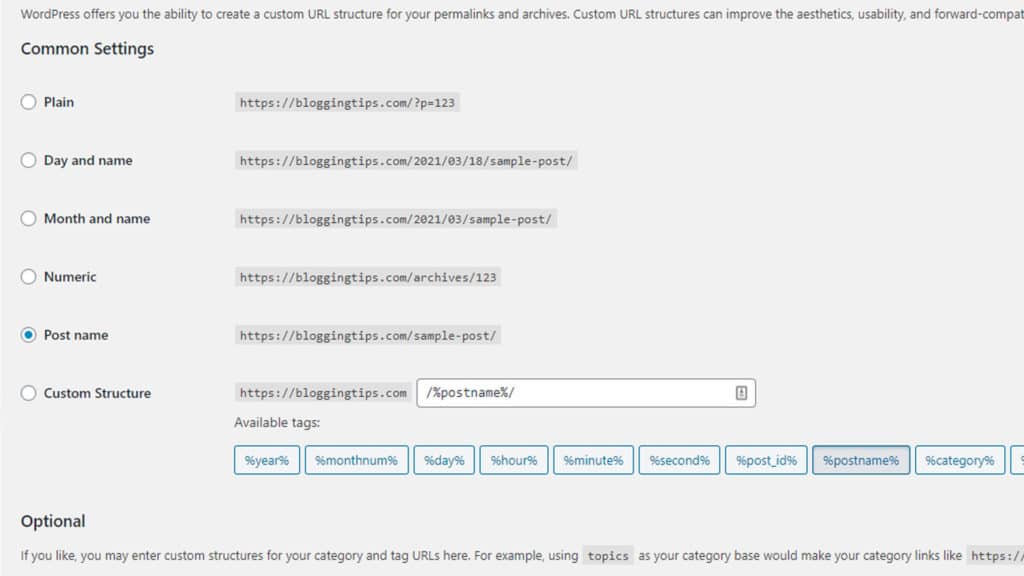As a blogger, you know that your blog’s permalinks are important.
They’re the permanent URLs to your posts and pages, and they’re what search engines use to rank your content.
But what many bloggers don’t know is that there are ways to optimize your permalinks for better SEO (search engine optimization).
In this beginner-friendly guide, we’ll teach you how to set up your permalinks for optimal SEO performance.
So whether you’re just starting or you’re looking to fine-tune your current setup, read on for tips that will help improve your blog’s SEO!
- What Are Permalinks?
- How To Optimize Your Permalinks For SEO
- Why Are Permalinks Important For Your Blog Posts And Website Pages?
- How To Change Your WordPress Permalinks In WordPress?
- How To Choose The Best Permalink Structure For Your WordPress Site?
- 05 Different Types Of Permalinks You Can Choose From:
- What Are Custom Permalinks?
What Are Permalinks?
A permalink is a permanent URL that points to a specific blog post or page on a WordPress website.
Permalinks are also sometimes called “permanent links” or “permanent URLs.”
When you create a permalink for a blog post or page, it should never change.
This is in contrast to a temporary URL, which can be changed at any time.
Permalinks are typically made up of the date of the post or page, followed by the post or page title.
For example, the permalink for this blog post might be “https://example.com/what-are-permalinks.”
If you change the permalink for a WordPress blog post or page after it’s been published, it can cause problems with search engine optimization (SEO) and lead to 404 errors.
As a result, it’s important to choose your permalinks carefully and make sure they never change.
How To Optimize Your Permalinks For SEO
There are a few things you can do to optimize your permalinks for better SEO.
First, try to use keyword-rich permalinks.
This means including one or two keywords in your permalink that are relevant to your post or page.
For example, if you’re writing a blog post about SEO, you might include the keywords “SEO” and “blogging” in your permalink.
Not only will this help your post or page rank higher in search engines for those keywords, but it will also help people who are looking for that information to find your content more easily.
In addition to using keyword-rich permalinks, you should also try to keep your permalinks as short as possible.
This is because longer permalinks can be more difficult for people to remember and type into their browser.
They can also be more susceptible to errors if someone mistypes part of the URL.
So when choosing your permalinks, aim for something short, sweet, and to the point.
Finally, it’s also a good idea to use hyphens (-) to separate words in your permalinks.
This is because search engines treat hyphens as spaces, which can help your content rank higher for those keywords.
For example, if you have a blog post with the permalink “https://example.com/SEO-blogging,” it will be easier for search engines to find and index that content than if the permalink was “https://example.com/seoblogging.”
Why Are Permalinks Important For Your Blog Posts And Website Pages?
WordPress Permalinks are important for a few reasons.

1. Search Engines Use Permalinks To Index The Content
Permalinks are how search engines find and index the content on your blog or website.
When a search engine crawls your site, it will follow the links to your posts and pages.
The URL of each post and page is known as the permalink.
By including keywords in your permalinks, you can help improve your blog’s SEO and make it easier for people to find your content.
2. Permalinks Are Permanent URLs
Permalinks are permanent URLs, which means they should never be changed.
Once you’ve published a post or page, the permalink should stay the same forever.
If you do change a permalink, it can cause problems with SEO and lead to 404 errors.
3. Permalinks Can Help People Find Your Content More Easily
If you choose your permalinks carefully, they can help people find your content more easily.
For example, if you include keywords in your permalinks, people who are searching for that information will be more likely to find your content.
Permalinks can be shared easily, which makes them a great way to promote your content.
When you share a permalink, people can click on it and be taken directly to that post or page.
Read the blog post “What Is A Blog? Definition, Types of Blogs, Examples & More”
How To Change Your WordPress Permalinks In WordPress?
If you’re using WordPress, there are a few different ways to change your permalinks.

Method 1: Change Your Permalinks In The WordPress Admin Dashboard
The easiest way to change your permalinks is from the WordPress admin dashboard.
To do this, simply log into your WordPress site and go to Settings > Permalinks.
From here, you can choose the permalink structure you want to use.
Method 2: Change Your Permalinks Via The WordPress Theme Customizer / WordPress dashboard
Another way to change your permalinks is via the WordPress theme customizer.
To do this, simply log into your WordPress site and go to Appearance > Customize.
Then, click on the Permalinks tab and choose the WordPress permalinks structure you want to use.
Also related: How To Monetize A Blog In 2022
Method 3: Change Your Permalinks Via The WordPress Code Editor
If you’re comfortable editing code, you can also change your permalinks via the WordPress code editor.
To do this, simply log into your WordPress site and go to Appearance > Editor.
Then, click on theTheme Functions (functions.php) file and add the following code:
function wpb_change_permalinks() {
global $wp_rewrite;
$wp_rewrite->set_permalink_structure( ‘/%postname%/’ );}
add_action( ‘init’, ‘wpb_change_permalinks’ );This code will change your permalinks to the /%postname%/ structure.
Method 4: Change Your Permalinks Via The .htaccess File
If you’re comfortable editing code, you can also change your permalinks via the .htaccess file.
To do this, simply log into your WordPress site and go to the root directory.
Then, edit the .htaccess file and add the following code:
RewriteRule ^([^/]+)/$ $1.htmlThis code will change your permalinks to the /%postname%.html structure.
How To Choose The Best Permalink Structure For Your WordPress Site?
There is no “perfect” permalink structure for all websites.
The best permalink structure for your website will depend on your individual needs and preferences.
However, there are a few things you should keep in mind when choosing a permalink structure.
First, you should avoid using long and complicated permalinks.
Not only are they difficult to remember, but they can also be a hassle to type into a browser.
If your permalinks are too long, people may be discouraged from visiting your website.

Second, you should use keywords in your permalinks whenever possible.
Including keywords in your permalinks can help people find your content more easily.
Finally, you should make sure your permalinks are compatible with the structure of your website.
For example, if you’re using a custom post type, you’ll need to use a permalink structure that is compatible with that post type.
It is better to create custom permalinks for your WordPress website.
The custom permalinks plugin provides an easy way to create custom permalinks for your WordPress posts, pages, and custom post types.
The default WordPress permalink structure in WordPress is not SEO friendly.
It is better to use a custom permalink structure that includes keywords.
In the default permalink setting, WordPress includes the date and time in the permalink.
This can be changed to a custom setting.
Important blog: 7+ Free Tools to Help You Increase Website Traffic Exponentially
05 Different Types Of Permalinks You Can Choose From:
When it comes to permalinks, there are a few different types you can choose from.
1. Post Name Permalink
The most common type of permalink is the post name permalink.
This type of permalink uses the post name as the URL.
For example, if your post name is “example-post”, your permalink would be “http://example.com/example-post”.
2. Day And Name Permalink
The day and name permalink are similar to the post name permalink, but it also includes the date of the post.
For example, if your post was published on January 1, 2020, your permalink would be “http://example.com/2020/01/01/example-post”.
3. Month And Name Permalink
The month and name permalink are similar to the day and name permalink, but it includes the month of the post instead of the day.
For example, if your post was published in January 2020, your permalink would be “http://example.com/2020/01/example-post”.
4. Numeric Permalink
The numeric permalink is the simplest type of permalink.
It uses the post ID as the URL. For example, if your post ID is “123”, your permalink would be “http://example.com/123”.
5. Custom Permalink
The custom permalink is the most flexible type of permalink.
It allows you to choose your URL for each post.
For example, if you wanted your post to have the URL “http://example.com/example-post”, you could use a custom permalink.
What Are Custom Permalinks?
Custom permalinks are permalinks that you can customize for each post.
To create custom permalinks, simply log into your WordPress site and go to the edit screen for the post you want to customize.
Then, scroll down to the Permalink section and enter the URL you want to use.
Benefits Of Using Custom Permalinks
There are a few benefits of using custom permalinks.
First, they allow you to choose your URL for each post.
This can be helpful if you want to use keywords in your URLs or if you want to make your URLs more descriptive.
Second, custom permalinks can help you organize your content better.
For example, if you have a lot of posts about different topics, you can use custom permalinks to group them.
Finally, custom permalinks can be helpful if you move your WordPress site to a new domain.
If you use the same permalink structure on both domains, all of your links will still work.
You can use a simple permalink structure, or create custom permalink structures.
Both are SEO-friendly and SEO-friendly permalinks are always the best.







